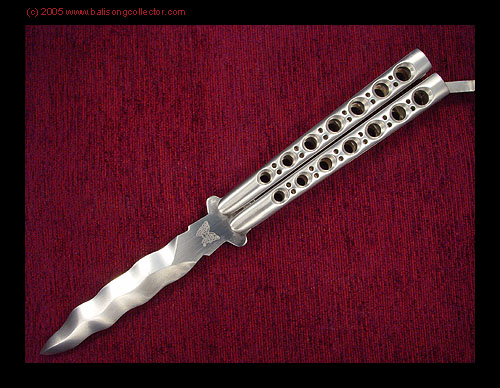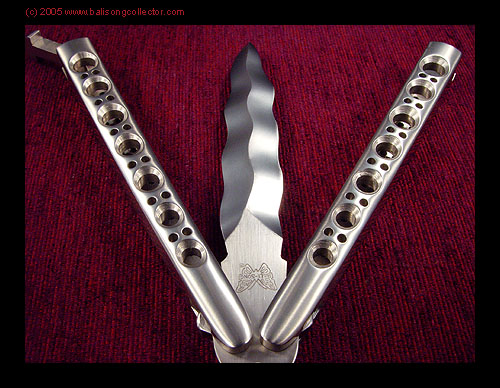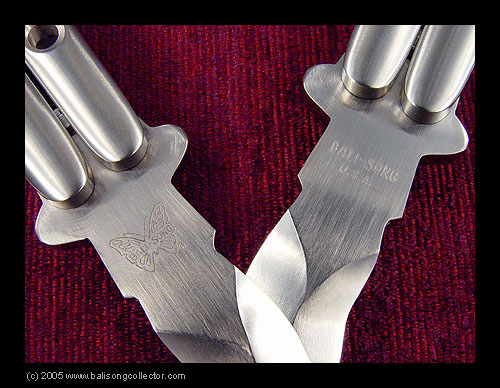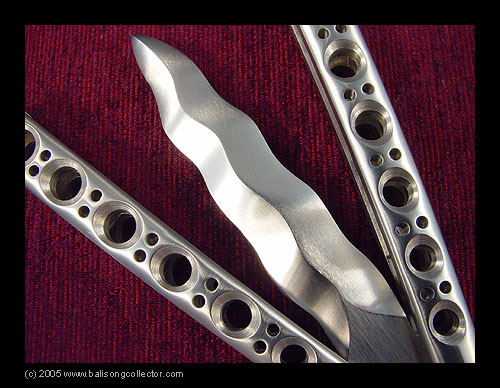

Kiss My Kris Throughout this exhibit, you may click on the pictures to see a higher-resolution version. The high- resolution pictures average about 550K. Each will open in a new window, so you may need to bypass any pop-up blocking software you use.

The kris-style blade with its undulating edges has its origins in Middle-Eastern knives and swords. I saw some wonderful, long kris-blade swords at the internationally-acclaimed State Hermitage Museum in St. Petersburg, Russia when I went to the Moscow Knife Show last year. These swords, centuries old, had been purchased by the Czars and elite of Russia from Persian makers. Many of the guns and swords of imperial Russia came from the Middle East. Today, however, the Kris-style of knife is most commonly associated with Indonesia and the Philippines. So, it is especially fitting that a balisong, a style of knife often associated with the Philippines, be presented with a kris-style blade.
Some have speculated that the undulating edge is like an exaggerated serration and intended to make the knife rip and tear through material better. But, as it has been explained to me, the purpose of the kris geometry is not slashing but rather stabbing. The curves on the kris help the knife find its way around impenetrable objects encountered while stabbing into otherwise soft material. One example might be a bone encountered while stabbing into an opponent's otherwise soft body. A knife or sword with an acute point might stick into the bone and be stopped. But a kris with its curves will deflect off of and around the bone and continue in deeper.
Today, the golden standard for the modern, American kris is -- without challenge -- set by Benchmade's recent Model 49 Bali-Song knives.

The merits of a modern, American, balisong kris are judged by the number of undulations over the length of the blade, the depth of the undulations, by the symmetry of the undulations, and by how the median ridge follows the undulations. Of course, one should also consider all the usual factors in judging the quality of a blade's grind.
The blades for the Benchmade 49s were not hand-ground. They were cut on a modern, CNC milling machine. The first wonderful technical accomplishment of these blades is in the programming of that machine which was done by Benchmade's master of CNC, Rick Thatch. The manufacturer of the CNC machine used initially said that it was incapable of cutting such a part due to the many compound angles and curves involved. Imagine the expression on their application engineer's face as he watched their machine cut this part. Obviously, Rick knows more about their machine than they do. The finishing and sharpening on these blades, the second wonderful technical accomplishment of them, was hand-done by Benchmade's then master craftsman Vance Collver and is no small feat on such a complex blade geometry.
The blade's five undulations are in perfect proportion to its four-inch length. The undulations are deep. The symmetry is perfect. The median ridge is sharp and perfectly follows the undulations of the edges. And the grind is a double-hollow-grind with a zero-bevel edge. It just doesn't get any better than this.
Now consider the kris which is the subject of this exhibit.

This knife was made in the mid 1980s at Pacific Cutlery, Benchmade's predecessor, in Hollywood, California. There were no CNC milling machines. The 303S (assumed) stainless steel handles were made on a manually-operated milling machine. The 440C (assumed) stainless steel blade was entirely hand-ground. The blade was, in fact, hand-ground by legendary bladesmith and knife and sword maker Jody Samson. Until the advent of the Model 49, Mr. Samson hand-ground all Bali-Song kris blades that carry the Bali-Song butterfly logo.
I've seen quite a number of Bali-Song kris knives and own a few. While they're all very nice, they do vary in quality considerably. This one presented here is the absolute best I have ever seen. This is a masterpiece.
It has five undulations in a four-inch blade. The undulations are deep. The symmetry is perfect. The median ridge, while not as sharp as that of the 49, is quite pronounced and follows the undulations perfectly. The symmetry of this blade is amazing. And, like the 49, this is a double-hollow-ground blade with a zero-bevel edge.

Remember, that blade was hand-ground about 20 years ago.
The front of the blade features the Bali-Song butterfly tang stamp with the (r) registered trademark. The back reads "Bali-Song <over> U.S.A."

A word about this picture: This is two pictures of the same knife which have been digitally-edited to appear as one picture. I have criticized other photographers for doing this sort of thing because I think it's deceptive and could mislead people into thinking that there are two such knives. When I put two pictures of the same knife into a single frame, I like to put a border around the inset picture or do something else to make it clear that these are two pictures of the same knife. Some have accused me of criticizing the editing of two pictures to look like one because they say I lack the technical skill to do it myself. Well, that's not true. And here's the dramatic proof.
Some may ask, "How can you tell the front from the back on a double-edge knife?" The front of a blade is the side you see when the knife is held with the edge toward the floor and the tip pointing off to your left. This is as you would hold the knife up in front of your eyes with the handle in your right hand and with the edge down toward the floor. The back of the blade is simply the other side. On a dagger or spearpoint, there often is no front and back because there are two identical edges and it's not clear which one to hold toward the floor; in this case, we just talk about one side and the other. But ,on a proper kris, the tip turns slightly at the end. To find the front, hold the knife in front of your eyes with your right hand with that final turn facing downward.
Again, notice the symmetry. Notice the depth of the hollow grind. Notice how perfectly the median ridge follows the undulations. And, again, remember that this blade was hand-ground. Bravo!

Bravo! All you can say is BRAVO!
This is the sort of masterpiece that one finds here... in the Balisong Collector's Vault.

Overall length open: 9 1/8 inches (23.2 cm)
Overall length closed: 5 3/16 inches (13.2cm)
Blade stock: 5/32 inch (4mm)
Weight: 7 3/4 ounces (220g)
Now, where would you like to go next:
![]() Back to The Balisong Collector's
Home Page
Back to The Balisong Collector's
Home Page
![]() See more pictures of outstanding balisongs in the
Galleries
See more pictures of outstanding balisongs in the
Galleries
![]() See what balisongs are for sale in the Shameless
Commerce Division
See what balisongs are for sale in the Shameless
Commerce Division